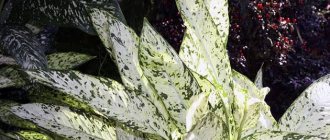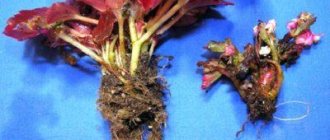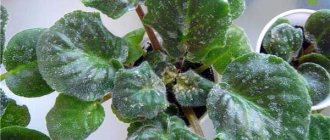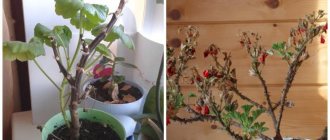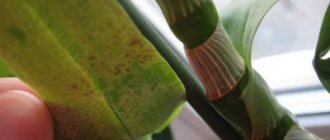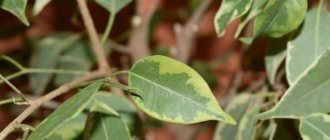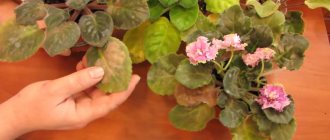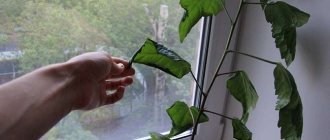Dieffenbachia quickly reacts to changes in conditions by deteriorating its appearance. Its leaves often turn yellow, and sometimes even experienced gardeners cannot confidently name the reason for this.
Indeed, yellowing of leaves is caused by many factors: very bright lighting, excessive watering, changes in temperature and humidity, attack by pests and some others.
In the article you will learn what to do if the leaves of Dieffenbachia turn yellow, and you will also see the reasons why this happens.
Direct sunlight
When direct rays of the sun hit the leaves of Dieffenbachia, yellow-brown burns are formed, which lead to yellowing and drying of the entire leaf.
It should be remembered that Dieffenbachia should not be kept in the sun, but in partial shade .
In summer, the plant should be placed on a south-eastern window, where the sun's rays will hit it only in the morning.
Here the lighting will be sufficient for good growth, but without direct sun. If this is not possible and Dieffenbachia grows on a south-facing window, it must be shaded to avoid burns.
In winter, the flower requires fairly intense lighting. It is better to move it to the most illuminated windowsill. Winter sun rays will not harm the flower; you should not be afraid of direct sun during the cold season.
Description of the plant
The leaves of this plant are oblong and, depending on the variety, have a different shade of green.
Dieffenbrachia has an interesting pattern on the leaves, consisting of:
The trunk of the plant is not high, and over time it becomes more gentle.
The only drawback of Dieffenbachia is its poisonous juice, which can cause swelling of the tongue and larynx, as well as cause loss of vision if the juice gets on the mucous membrane of the eye.
Flower juice can cause more harm to children and pets
That is why it is worth observing safety measures and caution for those people who still decide to have such a flower at home.
Strong hydration
Excessive moisture leads to fungal diseases of the plant
Excessive soil moisture easily leads to various fungal diseases. When the roots rot, the leaves of the plant first fall down and then begin to turn yellow. Moreover, the plates throughout the plant turn yellow.
In case of rotting, Dieffenbachia needs an emergency transplant and reduced watering , and sometimes this does not help. We have to cut off and root the surviving tops.
To protect the plant from rotting, it is necessary to strictly adhere to its watering regime. You can’t overwater the flower, but you shouldn’t overdry the earthen ball either, as this can cause the death of the plant. Keeping the soil moist but not wet is quite simple. Watering is carried out only after the top layer of soil in the pot has dried to a depth of 2-3 cm.
Sometimes plants turn yellow as a result of root rot and with the correct watering regime. This happens when the soil composition is incorrectly selected. The soil for Dieffenbachia should be light. In heavy soils, water stagnation and root rot are possible.
Low air humidity
With insufficient watering and low humidity, Dieffenbachia leaves begin to turn yellow from below. First the tips turn yellow, then the entire leaf blade. Such plates dry out and fall off over time. This is often accompanied by loss of color and lightening of the upper leaves.
Often in a city apartment it is difficult to create the necessary air humidity for Dieffenbachia . In summer, the room is quite hot and dry; in winter, during the heating season, the air is dried out greatly by heating radiators. Therefore, for many inexperienced gardeners, Dieffenbachia is a long bare trunk with several leaves at the top.
For a plant to maintain its beauty, regular watering and spraying is not enough. It is useful to place it in a tray with a damp substrate: expanded clay, sand or moss. The substrate will humidify the air near the plant and also help preserve its green mass.
Reduced temperature and draft
Dieffenbachia is a heat-loving tropical plant. At low temperatures, Dieffenbachia can drop all its leaves (especially if the temperature drops sharply).
The leaves turn yellow very quickly throughout the plant and fall off, except for the very top ones.
The reaction of Dieffenbachia to a draft is drying out and yellowing of the tips of the leaves. If such symptoms occur, you need to move the plant away from opening windows, otherwise it may turn completely yellow and then lose all its foliage.
Dieffenbachia can also react when kept in an air-conditioned room. If you are near an air conditioner under a stream of cold air, it will certainly shed its leaves and lose its beautiful appearance.
You cannot keep this plant not only under air conditioning, but even away from it, because it does not tolerate temperature changes in such a room very well.
Pest infestation
When attacked by spider mites, yellow spots first appear on the leaves of the plant, which then cover the entire leaf blade.
This pest is easy to detect on the underside of leaves, which can be completely covered with a thin web. Typically, treatment with special chemicals allows you to quickly destroy the pest.
Already yellowed plates cannot be restored . Over time, they dry out and fall off. But eliminating mistakes in plant care will lead to the growth of young, healthy greenery.
Bush varieties will acquire lush shapes and green coloring. It is better to renew old tall plants that have lost their leaves by cutting off and rooting the tops. After this, the new plants need to create optimal conditions for growth and development.
Why do Dieffenbachia leaves turn yellow and dry?
Since the exotic guest is quite capricious, her leaves often turn yellow and dry. This can be caused by both disturbances in the care process and diseases, which are quite common for this particular type of plant. Why do plant leaves turn yellow?
Violation of care rules
Several factors can lead to violation of plant care rules. In the first place is improper watering - it can be either excessively abundant or insufficient. The air in the room where Dieffenbachia is located can be very dry. This also applies to office premises, where the lighting is in most cases artificial, and the flowerpot itself is on the windowsill, where sunlight practically does not penetrate. No matter how strange it may sound, pets may also be involved in violations of plant care. They may chew or scratch the leaves of the flower, but the damage may not be noticeable at first glance. In this way, an infection can be introduced that interferes with the normal development of the plant.
Dieffenbachia diseases and methods of their treatment
Dieffenbachia, like any living creature, can get sick and be affected by infections. Fungal, bacterial and viral diseases can interfere with the normal development of the plant. Leaf spotting, which forms first at the edges of the foliage and then spreads to the entire blade, can be caused by improper room temperature or high humidity. Overwatering and accumulation of liquid in the soil can also cause stains. To avoid such phenomena, it is necessary not only to reconsider the systematicity of irrigation, but also the water itself that is used for these purposes.
Anthractic disease - with a fungal disease, the stems and leaves are affected by small orange spots, which over time merge into one large lesion, leading to complete drying of the leaf. It occurs for the same reasons as regular spotting. Treatment of affected areas of the plant is carried out by spraying Dieffenbachia with fungicides.
Fusarios is an infectious flower disease that affects the roots and basal part of Dieffenbachia. Long orange spots appear on the affected areas, which lead to drying out and death of the plant. The appearance of such an infection is caused by overdried soil and lack of fertilizers. To cure a tree, you need to remove the roots from the pot, rinse it under water and get rid of the contaminated soil. Then spray the roots several times with preparations containing fungicides and transplant the plant into new soil.
How to deal with Dieffenbachia pests (video)
Root rot can also lead to yellowing and drying of leaves. To do this, as in the previous case, it is necessary to dig out the roots and clean them of infection. If the roots are black and have an unpleasant odor, this is a sure sign of disease. It can be caused by overwatering. To treat Dieffenbachia, you need to clean the infected roots, replant it in a new place, treat the soil with a fungicide and reconsider the watering.
Dieffenbachia pests affecting the condition of leaves
Despite the fact that Dieffenbachia is partly a toxic plant, it is also susceptible to attack by pests that damage it and affect the foliar system. The most common parasites include:
- spider mite
- aphid
- mealybug
- scale insect
The methods of control for each type of parasite are the same - it is necessary to thoroughly treat the trunk and leaves of the indoor flower with a soap solution, and then wash it off the surface of the flower with ordinary warm water. After this, you need to treat the Dieffenbachia with a specially prepared insecticide solution. If there are two or more plants in the house, it is necessary to treat the remaining home window inhabitants, since parasites tend to move from one plant to another.
Natural causes
Natural causes can also lead to yellowing of Dieffenbachia leaves. In general, this is a natural process that affects older lower leaves. However, when the first spots and dry areas appear on the leaves, there is no need to rush to get rid of them and cut them off at the root. You need to wait until the leaves are completely dry and begin to fall off. Flower growers claim that pruning leaves causes great harm to the plant.
Other causes of yellowing Dieffenbachia leaves
Let's look at other possible causes of yellow leaves in Dieffenbachia.
Lack of lighting
The leaves of Dieffenbachia can turn yellow not only with excess, but also with insufficient lighting. If you keep the plant in partial shade, it will very soon begin to shed its leaves. First, the lowest leaf blades will turn yellow and fall off, then the flower will lose most of its green mass.
Thus, the reason why the lower leaves of Dieffenbachia turn yellow is lack of lighting.
Very often, leaf fall begins in winter. Due to the small amount of sun and short daylight hours, the plant trunk becomes elongated and exposed, and the leaves fall off. At this time of year, it is better to illuminate the plant with special lamps, lengthening the daylight hours.
Lack of nutrition or excess of minerals in the soil
Dieffenbachia responds very quickly to the amount of nutrients in the soil. When there are not enough of them, it sheds its leaves. This happens in the absence of feeding or in the absence of regular transplants. Therefore, it is necessary to replant even the largest plants, since ordinary soil fertilization is not enough.
Sometimes Dieffenbachia is fed too often and intensively . Excess nutrition can also cause leaves to turn yellow. This plant must be fertilized very carefully; a high concentration of fertilizers will lead to leaf fall and loss of decorative appearance.
Incorrectly selected soil composition
Dieffenbachia is very demanding on the composition of the soil.
The acidity of the soil most affects its appearance. The plant does not tolerate alkaline soils and responds very quickly to the presence of lime in the soil. With such a soil composition, all the leaves of this flower may turn yellow in a short time. To preserve Dieffenbachia, an emergency transplant into soil of a suitable composition will be required.
Fungal diseases
Dieffenbachia, which belongs to tropical ornamental crops, is often subject to fungal diseases. The main reasons are high humidity and high indoor air temperature, as well as excessive watering. If you notice that Dieffenbachia has stopped growing and developing, has begun to wither, turn yellow, bend toward the ground, or dry out, reconsider the growing conditions and the features of caring for your indoor flower.
Anthracnose
Spores of the fungus Colletotrichum gloeosporioides lead to the development of anthracnose. First, small spots appear on the leaves, which gradually grow and cover the entire surface of the leaf plate. The leaves begin to curl inward or, conversely, unwind outward. The cuttings die, as a result of which the leaves fall off. When answering the question of what to do if the leaves of Dieffenbachia turn yellow, it is recommended first of all to reconsider the conditions in which the ornamental crop grows. Leaves may curl or open incorrectly as a result of inappropriate humidity and high air temperatures. Systemic preparations with fungicidal action will help effectively cope with anthracnose, in particular we are talking about “Vitaros” and “Fundazol”.
Fusarium
Fusarium blight is caused by fungi of the genus Fusarium solani and appears as dark depressed spots on the roots and root collar of Dieffenbachia. As a result of damage to the root system, the leaves begin to turn yellow, turn in the opposite direction and wither. In this case, the damaged areas are covered with pinkish mycelium of the fungus. In order to prevent fusarium, you can use Glyokladin and Trichodermin, but if there is an abundance
Leaf spot
Phaeosphaeria eustoma fungi provoke the development of leaf spot in Dieffenbachia. Fungal spores are transmitted by infected plants and also by water. The main signs of the disease are small brown droplets with bright orange edges on the leaves of the indoor flower.
The disease develops rapidly, the spots increase in size and cover an increasingly larger area of the leaf plate. To cope with leaf spotting, you need to maintain optimal temperature conditions in the room and appropriate air humidity. At the first symptoms, it is recommended to treat indoor flowers with Fundazol or Vitaros.
Root rot
The main causes of root rot include: contaminated soil, lack of a drainage system, excess moisture in the soil, high air temperature, poor room ventilation, lack of lighting, improper application of fertilizers, etc. Many novice gardeners are interested in how to effectively deal with root rot. In addition to following the technique of growing Dieffenbachia, it is recommended to partially replace the substrate, feed the flower with potassium fertilizers and treat it with a systemic fungicide. In this case, “Profit Gold”, “Previkur” or “Ridomil Gold” are suitable.
Bacteriosis
Sometimes Dieffenbachia suffers from bacteriosis, which manifests itself in the form of watery spots with clear boundaries of a gray or brown tint. In this case, not only the aboveground, but also the underground part of the plant trunk suffers. Over time, gray-brown watery spots begin to appear on the leaves.
Unfortunately, bacteriosis is a bacterial disease that is almost impossible to cope with. If a houseplant is affected by the pathogens of this disease, it is necessary to treat the flower with copper sulfate or Bordeaux mixture, after first removing the damaged leaves and branches. Follow agricultural practices and always work with clean tools.

